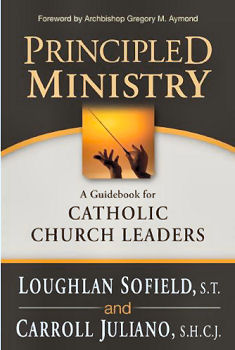
|
Posted February 12, 2011
Book: Principled Ministry: A Guidebook for Catholic Church Leaders Authors: Loughlan Sofield, S.T. and Carrol Juliano, S.H.C.J. Ave Maria Press, Notre Dame, IN. 2011, pp. 141 An Excerpt from the Jacket:
– Set boundaries – Facilitate, don’t dominate – Think developmentally – Be comfortable with conflect – Avoid ambiguity An Excerpt from the Book: Principle 10: Facilitate, don’t dominate One mantra for a pastoral leader is ‘never do for others what they can do for themselves.’ In other words, facilitate, don’t dominate. This principle, which sounds so simple, is often a stumbling block for those in helping roles such as ministers, caregivers, and pastoral leaders. Those who work with others who are especially vulnerable, such as the very young, the very old, and the infirm, are particularly prone to doing too much for the people whom they serve. It is often disrespectful and an affront to human dignity to do for others what they are capable of doing for themselves. There are a number of reasons why leaders fall prey to overstepping boundaries and providing care to those who are capable of taking care of themselves: 1) the action responds to a need in the helper, 2) there is a misperception of need, 3) the helper is trying to maintain a sense of superiority, and 4) simple arrogance. One area where it is most difficult to see the potential in the other is when someone we know and love begins to experience diminishment, as with aging or poor health. A common response to watching a loved one struggle with simple activities is to prematurely rush in and do for them what they are capable of doing for themselves. This response can be an unconscious attempt to allay one’s own discomfort and feelings of helplessness rather than a genuine response to the needs of the other. I experienced this when my then ninety-two-year-old mother lost her sight. I found myself rushing in too frequently to assist her with simple tasks that had become more difficult for her. She ultimately convinced me that she was capable of doing much more than I allowed her to do. I had to learn to become more patient because my overhelping wasn’t really helping her. Rather, I was allaying my own pain at seeing her grow old and frail. When we are more overly solicitous and protective of people than is required, we too easily contribute to their deterioration. The model for implementing this principle of not doing for others what they can do for themselves is Jesus Christ. Throughout the gospels Jesus is revealed as a caring, compassionate person, one who constantly saw gift and potential in others that was evident to only a few. He took a motley group of fishermen, prostitutes, tax collectors, and outcasts and challenged them to do what few before or since have done because he saw and respected their potential. Table of Contents:The Ministry of Jesus: Pre-eminent model for Church leadershipThe self-defined leader1. Set boundaries2. Trust your gut 3. Think tenses 4. Be comfortable with conflict 5. Avoid niceness 6. Seek supervision and consultation The discerning leader7. Act like a chameleon8. Assess the desire and capability of the other to change 9. Think developmentally 10. Facilitate, don’t dominate 11. Feed and frustrate 12. Consider multiple causes and multiple responses 13. Think needs Tasks, functions, roles, and skills of principled ministry14. Avoid ambiguity15. Create a climate that fosters dialogue 16. Be direct, gentle and consistent 17. Model and challenge 18. Avoid triangulation 19. Collaborate 20. Learn to deal with difficult people 21. Be a vision maker The leader as change agent22. Stay with the pain23. Avoid preaching and teaching 24. Focus on others as allies, rather than adversaries 25. Recognize parallel process 26. Explore parallel process 28. Think culture 29. Avoid labeling 30. Be competent and compassionate. |
|
